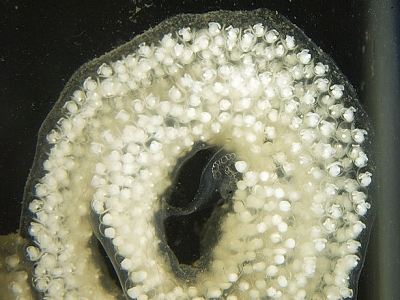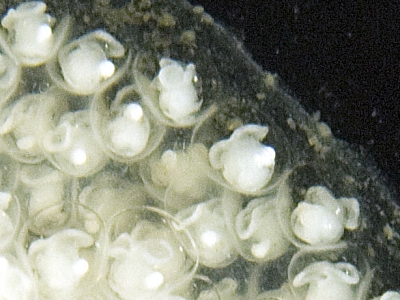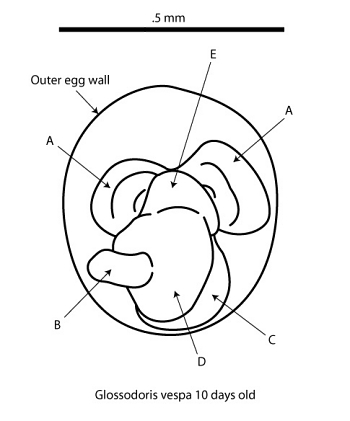Glossodoris vespa eggs at 10 days old
November 21, 2007
From: Gary Cobb


HI Bill and everyone!
Following on yesterday's message of Glossodoris vespa [#21152] showing the eggs at 9 days, here are photos after 10 days - and what a view! I drew a line drawing and was wondering if you could indentify the parts. Will they develop more and will the shape change too??
Locality: Old Woman Island, Mooloolaba, Sunshine Coast, 14 m, Queensland, Australia, Pacific Ocean, 20 November 2007, Subtidal. Length: 38 mm. Photographer: Ross Eason.
Thanks
Gary Cobb
gary@nudibranch.com.au
Cobb, G.C., 2007 (Nov 21) Glossodoris vespa eggs at 10 days old. [Message in] Sea Slug Forum. Australian Museum, Sydney. Available from http://www.seaslugforum.net/find/21168
Dear Gary,
Another interesting post. Opisthobranch eggs can develop in a number of different ways. The most primitive way, and probably the most common is what is called planktotrophic in which the fertilised egg begins to divide and develops into a shelled veliger larvae with large wing-shaped velar lobes. This veliger larvae hatched out of the egg capsule and swims away, feeding on one-celled algae for a time before settling out of the plankton and turning into a microscopic crawling slug. A second type of development is called lecithotrophic and in this case a swimming veliger larvae emerges from the egg capsule, but does not feed in the plankton, and spends only a few hours to days in the plankton before turning into a small slug.
The third development type is called direct development because the embryo turns into a crawling slug within the egg capsule and hatches out as a small crawling slug. There is a whole range of direct developers from those which shpw no real sign of a veliger larvae in the grwth of the embryo to others which go through a recognisable veliger stage in the egg capsule before dropping the shell and turning into a slug all within the egg capsule.
I previously referred to Nerida Wilson's paper where she reports the development of Glossodoris vespa as ametamorphic direct which means that the embryo doesn't develop into a recognisable veliger larvae in the egg capsule before turning into a crawling slug. 'Ametamorphic direct' is a term given to species in which there is little sign of a veliger stage. However the A structures in your drawing are velar lobes, so they are quite a bit larger than I would expect in a species with ametamorphic development. However they don't seem to have long cilia along the edge so we can probably call them vestigial. Labelling development types is difficult because there are always species which straddle the border between one type and another.
I am not sure of all the structures you have labelled but here is my best guess:
A, velar lobes
B, I guess this is the white structure in your photos. I suspect this is the larval kidney - a temporary structure lost after hatching.
C, This is probably the larval shell. In direct developer it is often reduced to a semispherical cap.
D, the body.
E, this is the larval foot.
I hope the larvae stay healthy until they hatch. It could be another couple of weeks before they do. I am not sure how you are keeping the egg ribbon but it may be an idea to change its water regularly.
- Wilson, N. G. (2002). Egg masses of chromodorid nudibranchs (Mollusca: Gastropoda: Opisthobranchia). Malacologia, 44(2): 289-305
Good luck,
Bill Rudman
Related messages
-
More feeding pics of Glossodoris vespa
From: David Mullins, December 11, 2008 -
Glossodoris vespa feeding
From: Gary Cobb, December 11, 2008 -
Glossodoris vespa hatching today
From: Gary Cobb, February 8, 2008 -
Glossodoris vespa eggs - progress report
From: Gary Cobb, December 11, 2007 -
Re: Egg mass of Glossodoris vespa
From: Gary Cobb, November 20, 2007 -
Egg mass of Glossodoris vespa
From: Gary Cobb, November 10, 2007 -
Re: Glossodoris vespa endemic to sthn Queensland
From: David Mullins, October 31, 2007 -
Glossodoris vespa endemic to southern Queensland, Austr
From: Gary Cobb, July 4, 2007 -
Glossodoris from Mooloolaba
From: Wayne Ellis, May 26, 1998
